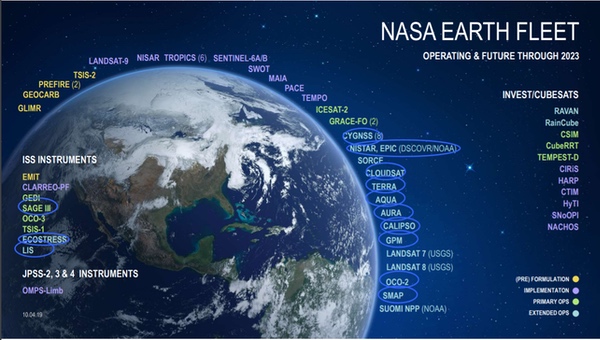Weighing overall societal benefit: Case studies on deciding when to deorbit satellites (part 2)by Marissa Herron
|
| As is the intent, the Senior Review process focuses on the scientific contribution, or the public good, against budget constraints, but not ODMSP compliance. |
The Senior Review process of the Earth Sciences missions is available on NASA’s website. The Review Panel considers “…the scientific performance of each mission and the continued relevance of each mission to the NASA Science Strategic Plan. Performance factors include scientific merit, national needs, the technical status of the mission, and budget efficiency. Missions that pass the senior review process may then be extended beyond their primary operational phase into an extended operational phase.”
Panel members can consist of “respected members of the science and academic communities and may include NASA employees not affiliated with the projects under review and representatives from other Federal, state, and nongovernmental organizations that use NASA data products for operational purposes.” A flow chart describing the overall process for the 2020 review demonstrates the review process (for the Earth Sciences Division).
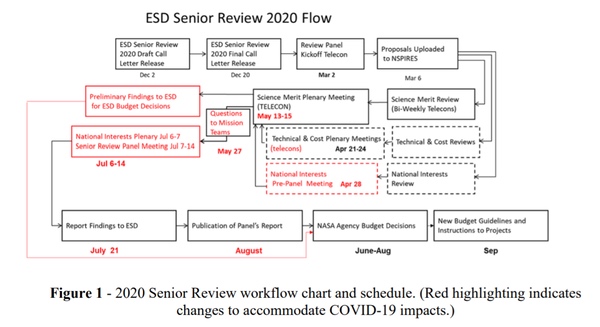 |
The 2020 Earth Science Division (ESD) Senior Review Kickoff presentation (below) provides a summary description for each of the above four parameters, or evaluation criteria, considered: scientific merit, national need, technical status, and budget constraints. The “Science” criterion evaluates each mission against its relevance to the latest Decadal Survey, which is the 2017 Survey for Earth Science. This criterion also assesses the quality of the data products, particularly the potential impacts that may occur during mission extension. Scientists value the consistency of a dataset and the long-term value that dataset can contribute to research. With these values in mind, the potential impacts of sensor or platform degradation during mission extension are carefully considered.
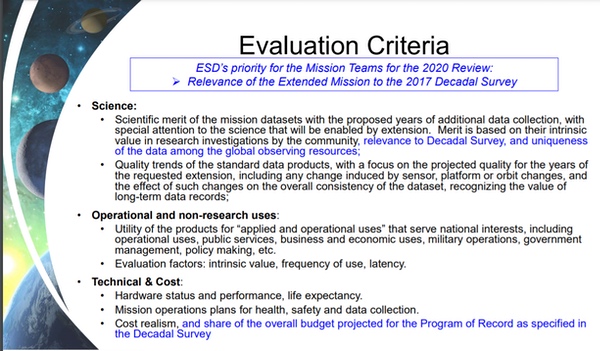 |
When considering the data products of each mission, the panel also considers how and by whom the data is being used. The table below (also from the 2020 ESD Senior Review) considers the various governmental and non-governmental entities that use each mission. The some-, high-, and very high-utility grades are represented by the purple, blue, and green colors, respectively.
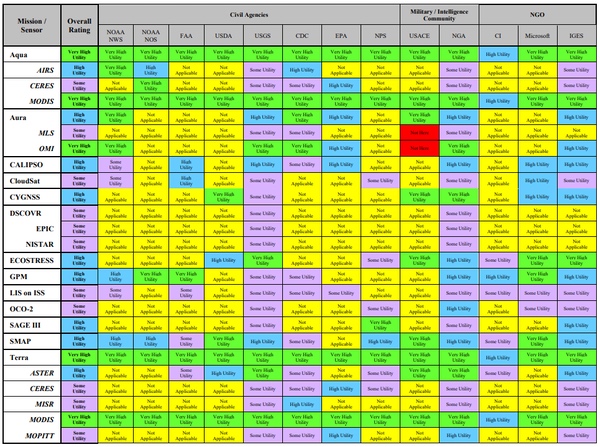 |
Terra and Aqua rank highly amongst all of the entities listed. The US Army Corps of Engineers (USACE) uses Terra for land cover and fire applications. The US Geological Survey (USGS) uses Terra for the mapping of minerals and volcanic hazards. Other entities use Terra data to assess the aerosol emissions, sea ice analysis, monitoring fire growth and fire detection, agricultural changes, carbon monoxide trends, and more. Aqua contributes data to weather prediction models, environmental health applications, monitoring of drought conditions, ice analyses, snow cover products, croplands for food security, water use assessments, drought studies, and natural resource assessments. The widespread use of these missions demonstrates great utility and continued contribution to the public, particularly when remembering that the data is provided as part of a free and open data policy.
| What happens when a mission is recommended for extension that will lead to non-compliance with ODMSP? |
The remaining two evaluation criteria, technical status and budget, consider the life expectancy of a mission. This assesses how the satellite hardware is performing, as well as the current and predicted health of the mission. The budget necessary to continue operating the mission and the proportion of the budget available is further evaluated.
The panel’s summarized assessment of these evaluation criteria for each mission considered during the 2020 review are summarized below. The panel recommended each of the missions for extension. Their scientific merit and relevance to the decadal survey were deemed appropriate for continued operations.
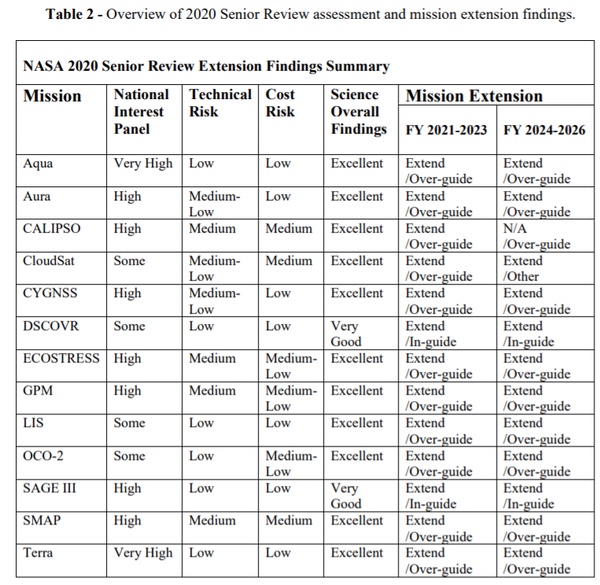 |
As is the intent, the Senior Review process focuses on the scientific contribution, or the public good, against budget constraints. The Senior Review process does not appear to address Orbital Debris Mitigation Standard Practices (ODMSP) compliance; however, these details are evaluated as part of the waiver process, if applicable.
What happens when a mission is recommended for extension that will lead to non-compliance with ODMSP? The existing process appears to prioritize the continued benefit of the public good (the science data) over the concerns for ODMSP non-compliance. To be fair, NASA carefully assesses all options to compliance and/or minimizing the risk associated with non-compliance. The TRMM mission is a good example of the consideration of the public good against a higher reentry risk. The value of the contribution was considered greater than the increased risk associated with an uncontrolled reentry.
Alternative approaches
The 2021 NASA IG Report expressed concern over the Terra and QuikSCAT missions due to their high mass, extended time in orbit, and explosive concerns. The report indicates that although NASA has done well with debris mitigation efforts, but the agency could benefit from alternative approaches such as debris removal.
At present, NASA’s satellites are built to minimize the amount of debris that survives reentry. This approach opens the opportunity for uncontrolled reentries, thereby reducing the dependency upon controlled reentries and valuable fuel resources. The remaining fuel can be used for on orbit collision avoidance maneuvers and mission extension.
NASA may benefit from additional approaches to ODMSP compliance, such as drag deployment devices or active debris removal (ADR). Drag deployment devices are mechanical methods that alter the exposed cross section of the satellite to the velocity vector. In other words, these devices change the shape of the satellite such that more drag is experienced causing the satellite’s orbit to decay faster. This approach is effective in LEO where a small amount of atmospheric drag remains. The risk of these deployment devices is accidental deployment. A premature deployment of a drag device is ultimately mission ending, so implementation of these devices will need to ensure reliability of the device and a willingness (or incentive) to accept the risk.
| The public good benefits of a government satellite will continue to challenge the 25-year disposal rule. |
ADR refers to the use of a satellite that intentionally removes defunct satellites from orbit. ADR has been discussed for decades with many creative concepts considered. The technology development is not the reason for lack of implementation. Instead, the cost of access to space remains high. Additionally, the uncertainties that come with deploying a new technology create additional concerns. For example, what if the ADR device unintentionally damages the target satellite? This would create more debris in orbit; potentially small, untrackable debris that can prematurely end the missions of nearby satellites. When ADR is eventually employed, the risks of both the new technology and the target satellite will need to be considered. At present, these risks and uncertainties create a disincentive to spending limited resources on removing defunct satellites as opposed to building new satellites for the science community.
Future Studies
Future exploratory efforts could include a review of other government agency satellites, such as NOAA, USGS, and DoD. These reviews could assess the passivation aspect of ODMSP and discuss the challenges of passivation. Consideration of the NOAA satellites that experienced multiple explosions of their defunct satellites due to battery issues can contribute to this study.
Similarly, commercial and international satellites could also be reviewed for the ability to meet ODMSP compliance and the obstacles they also encounter. The cost of mitigation efforts in the design phase and the cost of operations could be compared to the cost of active debris removal missions, or even the cost of satellite servicing and refueling missions. Northrop Grumman completed two privately funded satellite servicing missions in 2020. These efforts were in GEO (not LEO), where a designated disposal orbit is used since atmospheric decay is not an option.
- What satellite servicing business cases exist?
- Could these business cases support satellite operations and also encourage sustainment of the environment?
- Could government agencies benefit from satellite servicing to extend the mission of a valuable satellite until a replacement is on orbit, and then properly dispose of the satellite at end of mission?
Launch vehicle debris is an often overlooked topic. A study of the mass, location, and time in orbit may reveal new opportunities for debris mitigation.
- Where and how much debris is left in orbit with each launch?
- How long does this debris last and whom does the debris impact?
- Can launch vehicles be upgraded to reduce the amount of debris released and at what cost?
Conclusion
The public good benefits of a government satellite will continue to challenge the 25-year disposal rule. Disposal, or debris removal, technologies exist. What remains to be seen is the incentivized application of these debris removal technologies. This is an area where the commercial sector, under regulatory incentivization, can demonstrate regular application of debris removal capabilities that potentially leads to services. Commercial satellites are typically not considered public goods and the benefit of a continued mission is done for profitable purposes. Regulatory incentivization could include reducing the disposal timeframe or creative approaches that support debris removal service business cases. Astroscale, for example, developed a business case on the anticipated failure of satellites in large constellations, such as Starlink and OneWeb. This company is now partnering with the New Zealand government for debris removal and the UK government to study potential debris removal targets. The private sector and international governments appear to be taking the lead in debris removal (and related satellite servicing) services. In 2021, the Space Force announced the Orbital Prime program, which is an effort to incentivize the development of on orbit servicing, assembly, and manufacturing (OSAM) services. These combined efforts appear to be headed in a direction that encourages the sustainability of the orbital environment.
Note: we are now moderating comments. There will be a delay in posting comments and no guarantee that all submitted comments will be posted.
